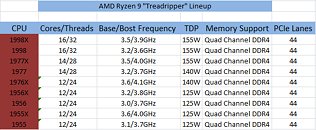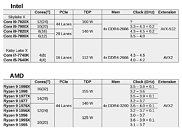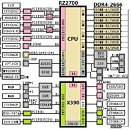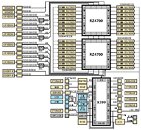Monday, May 15th 2017

AMD Ryzen 9 "Threadripper" Lineup Leaked
Today is an eventful day in the tech world, with two high-impact leaks already offering themselves up to our scrutiny. We had previously covered AMD's upcoming HEDT platform, based on the company's new X399 chipset, as having a quite distinctive lineup of processors, with not only 16 and 12-core offerings hot on foundries presses', but also some 14-core, 28-thread chips as well. Now, a leak has apparently revealed the entire Ryzen HEDT platform, whose processor marketing name, Ryzen 9, sounds really close to Intel's Core i9.
AMD's offerings look to offer an edge at least on core-count, with the Red team's top offerings, the Ryzen 9 1998X and Ryzen 9 1998, bringing in a game-changer 16 cores and 32 threads to the table. Perhaps even more importantly, we have to mention that the 1998X (these names, if true, are quite a mouthful, though) achieves a 3.5 GHz base, 3.9 GHz boost clock, which owes nothing to AMD's Ryzen 7 1800X consumer flagship CPUs. Rumors of AMD's frequency demise on higher core-count Ryzen CPUs have been greatly exaggerated, it would seem. And did I mention that these chips are coming with a TDP of 155 W - 5 W lower than Intel's purported 12-core, i9-7920X offering? Consider that for a moment.The 14-core parts are reported to be the Ryzen 9 1977X and Ryzen 9 1977. The Ryzen 9 1977X is a 155 W 14-core, 28-thread processor with a base clock speed of 3.5 GHz and a boost clock speed of 4.1 GHz with XFR. The Ryzen 9 1977 brings those speeds down a bit towards 3.2 GHz base and 3.7 GHz boost, with a correspondingly lower TDP of 140 W.
On to the 12-core parts, three different processors are expected: the Ryzen 9 1976X, Ryzen 9 1956X and the Ryzen 9 1956 (strange naming scheme with that 2-algharism difference between two parts with the same number of cores, I'd say.) The Ryzen 9 1976X is a 12-core, 24-thread, 140 W part, with a base clock 3.6 GHz and a boost clock speed of 4.1 GHz with XFR; the Ryzen 9 1956X lowers the TDP to just 125 W, on account of a lower base clock speed of 3.2 GHz and a boost clock speed of 3.8 GHz with XFR. The entry level 12 core part, the 1956, is rated at the same 125 W while running at a base clock speed of 3.0 GHz and a boost clock speed of 3.7 GHz.
There are also supposed to be two 10-core CPUs in this lineup, both rated at 125 W. The Ryzen 9 1955X, which runs at 3.6 GHZ base, and 4.0 GHz boost with XFR, and the Ryzen 9 1955, which runs at a base clock of 3.1 GHz and a 3.7 GHz boost.
I have to say, AMD is doing an amazing job with its Ryzen lineup, and the absolutely bonkers core-count on this X399, Whitehaven platform is most likely than not run circles around its Intel counterparts. Gone are the days of AMD's higher core count at the expense of computational power and IPC; as we've seen, AMD's Ryzen has achieved a great enough boost to its IPC that it can leverage its higher number, svelter cores over Intel's architecture, with absolutely mind-blowing TDP numbers (really, take another look at those TDPs in comparison to Intel's Core i9 series.)AMD's Whitehaven platform looks to be an attractive prospect. Let's just hope AMD's platform stability and compatibility quirks are fully ironed-out until the expected June release.
Source:
WCCFTech
AMD's offerings look to offer an edge at least on core-count, with the Red team's top offerings, the Ryzen 9 1998X and Ryzen 9 1998, bringing in a game-changer 16 cores and 32 threads to the table. Perhaps even more importantly, we have to mention that the 1998X (these names, if true, are quite a mouthful, though) achieves a 3.5 GHz base, 3.9 GHz boost clock, which owes nothing to AMD's Ryzen 7 1800X consumer flagship CPUs. Rumors of AMD's frequency demise on higher core-count Ryzen CPUs have been greatly exaggerated, it would seem. And did I mention that these chips are coming with a TDP of 155 W - 5 W lower than Intel's purported 12-core, i9-7920X offering? Consider that for a moment.The 14-core parts are reported to be the Ryzen 9 1977X and Ryzen 9 1977. The Ryzen 9 1977X is a 155 W 14-core, 28-thread processor with a base clock speed of 3.5 GHz and a boost clock speed of 4.1 GHz with XFR. The Ryzen 9 1977 brings those speeds down a bit towards 3.2 GHz base and 3.7 GHz boost, with a correspondingly lower TDP of 140 W.
On to the 12-core parts, three different processors are expected: the Ryzen 9 1976X, Ryzen 9 1956X and the Ryzen 9 1956 (strange naming scheme with that 2-algharism difference between two parts with the same number of cores, I'd say.) The Ryzen 9 1976X is a 12-core, 24-thread, 140 W part, with a base clock 3.6 GHz and a boost clock speed of 4.1 GHz with XFR; the Ryzen 9 1956X lowers the TDP to just 125 W, on account of a lower base clock speed of 3.2 GHz and a boost clock speed of 3.8 GHz with XFR. The entry level 12 core part, the 1956, is rated at the same 125 W while running at a base clock speed of 3.0 GHz and a boost clock speed of 3.7 GHz.
There are also supposed to be two 10-core CPUs in this lineup, both rated at 125 W. The Ryzen 9 1955X, which runs at 3.6 GHZ base, and 4.0 GHz boost with XFR, and the Ryzen 9 1955, which runs at a base clock of 3.1 GHz and a 3.7 GHz boost.
I have to say, AMD is doing an amazing job with its Ryzen lineup, and the absolutely bonkers core-count on this X399, Whitehaven platform is most likely than not run circles around its Intel counterparts. Gone are the days of AMD's higher core count at the expense of computational power and IPC; as we've seen, AMD's Ryzen has achieved a great enough boost to its IPC that it can leverage its higher number, svelter cores over Intel's architecture, with absolutely mind-blowing TDP numbers (really, take another look at those TDPs in comparison to Intel's Core i9 series.)AMD's Whitehaven platform looks to be an attractive prospect. Let's just hope AMD's platform stability and compatibility quirks are fully ironed-out until the expected June release.





83 Comments on AMD Ryzen 9 "Threadripper" Lineup Leaked
Oh well, it's not as if I need any of this, nor do I think I'll be able to afford it :p
The 1976X doesn't make sense though, as it's faster than the 1977 and 1977X, yet has the same amount of cores/threads.
Edit: Right, WCCF fucked up, if you read their text, the 1976X is a 12-core part, not 14, as in their table. Something I just noticed TPU fixed.
So, those are 1,000CAD+ CPUs?
And it's worthwhile to note that AMD's TDP and Intel's TDP definitions are entirely different.
Who knows though, but at least it's not a WAFFLESFTW1111111GOAT.
Are we learning yet?
And about those TDPs, if they are measured the same way, downclocking intel to AMD level should bring the TDP within the same range. So I'm not seeing anything breakthrough here.
@mcraygsx 1955 is also HEDT.
But certainly not at 1k+ price. I bought mine for 300USD/400USD each.
I say let the CoreWars commence!
HEDT let you use your PC for entertainment as well as for analysts, designers, content creation professionals, developers or whatever your specific needs are. I am not sure who fed you the idea that HEDT do not need 16 cores? That is the whole point of HEDT.
If you're still averse to MCP then there's always the p4 that can be OC beyond SB, with dry ice or liquid helium if need be.